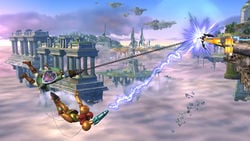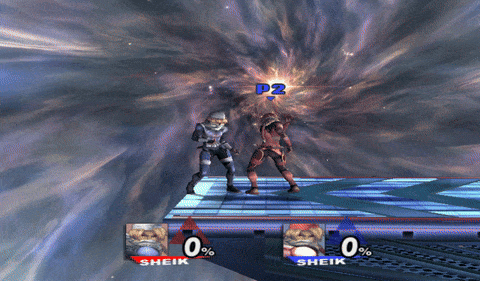Tether recovery: Difference between revisions
(safer than what? tether works the same as grabbing the edge normally as far as edgehogging goes, nobody else can grab regardless.) |
m (Undid edit by 152.172.1.179: unexplained removal) Tags: Undo Mobile edit Advanced mobile edit |
||
| (195 intermediate revisions by 95 users not shown) | |||
| Line 1: | Line 1: | ||
{{ArticleIcons|brawl=y|ssb4=y|ultimate=y}} | |||
[[File:SSB4 - Tether Recovery.jpg|250px|thumb|{{SSB4|Link}} and {{SSB4|Samus}} using their tether recoveries in ''Smash 4''.]] | |||
[[File:Sheik Side B SSBB 2.gif|250px|thumb|{{SSBB|Sheik}} using [[Chain]] as a tether recovery in ''Brawl''.]] | |||
A '''tether recovery''' ({{ja|ワイヤー復帰|Waiyā Fukki}}, ''Wire Comeback'') is a type of [[recovery]] move in ''[[Super Smash Bros. Brawl]]'', ''[[Super Smash Bros. 4]]'' and ''[[Super Smash Bros. Ultimate]]'' that lets the player latch onto the [[edge]] of a [[platform]] with an extendable item or hook. If there is an open edge when it is used, the tether will automatically connect to it. Pressing the standard attack button after grappling an edge will pull the player towards it. Tether recoveries are effectively the successor to the [[wall-grapple]]s in ''[[Super Smash Bros. Melee]]'', though tethers can only grab onto unoccupied edges as opposed to any wall. Most tether recoveries are [[grab aerial]]s, though some [[special move]]s and [[aerial attack]]s also act as tethers. | |||
Contrary to what they may appear as, most non-grab aerial tethers are '''not''' a [[command grab]]; rather, they utilize a standard hitbox with a property of sweetspot edges, as with most non-tether [[up special]]s as well as other recovering moves; in fact, [[Fishing Rod]], [[Grappling Hook]] and [[Sword of the Creator]] are the only non-grab aerial tethers that function as a command grab (although they have [[Grab#Hitboxes that can grab|slightly different properties]] from standard command grabs). | |||
Many tether recoveries have a larger range than regular recoveries and also home in on the edge, allowing for better control. However, in ''Brawl'', if the edge is currently occupied when a tether recovery is used, it will fail to grab onto the edge (the player can, however, knock other players off the edge should the tether hit the opponent). None of the other players can grab the edge while a player is attached to it with a tether (prior to ''SSB4''), making it a method of [[edge-hogging]] other players. A tether recovery can only be used three times without touching the ground; if it is used a fourth time, the tether will simply hover near the edge, and the player will have to make use of their remaining [[jump]]s. After grabbing an edge with a tether, there is a short cooldown before the player can tether onto an edge again. In ''Ultimate'', tether recoveries also count towards the newly introduced ledge grab limit. Attempting to tether after the limit is reached will have the tether bounce off the ledge. Simply tethering the ledge will add to the limit, even if the user does not retract the tether to grab the ledge themselves. Doing so however will not add an additional grab to the limit. | |||
[ | |||
[[Category:Game | As of ''[[Super Smash Bros. 4]]'', multiple characters can latch onto a ledge at once if using their tether, but once players pull up to the ledge, normal ledge grabbing rules apply. | ||
In ''[[Super Smash Bros. Ultimate]]'', regrabbing a ledge with a tether recovery gradually decreases the [[intangibility]] on getup, as a part of the new universal ledge mechanic. However, unlike normal ledge grabs, tether recoveries do not remove the intangibility when hanging on a ledge for unknown reasons<ref>https://www.twitter.com/Tilted_as_fuck/status/1222252893249601536</ref>. | |||
==In ''[[Super Smash Bros. Brawl]]''== | |||
===List of tether recoveries=== | |||
[[Up special]]s: | |||
*{{SSBB|Zero Suit Samus}} - [[Plasma Wire]] | |||
*{{SSBB|Ivysaur}} - [[Vine Whip]] | |||
*{{SSBB|Olimar}} - [[Pikmin Chain]] | |||
[[Side special]]s: | |||
*{{SSBB|Sheik}} - [[Chain]] | |||
*{{SSBB|Zero Suit Samus}} - [[Plasma Whip]] | |||
[[Grab aerial]]s: | |||
*{{SSBB|Link}} - [[Clawshot]] | |||
*{{SSBB|Samus}} - [[Grapple Beam]] | |||
*{{SSBB|Toon Link}} - [[Hookshot]] | |||
*{{SSBB|Lucas}} - [[Rope Snake]] | |||
Note that characters that have tether recoveries as a special move cannot use their extended grab as one. | |||
==In ''[[Super Smash Bros. 4]]''== | |||
Several characters with tether recoveries had their movesets changed while Ivysaur was cut. | |||
===List of tether recoveries=== | |||
[[Grab aerial]]s: | |||
*{{SSB4|Link}} - [[Clawshot]] | |||
*{{SSB4|Samus}} - [[Grapple Beam]] | |||
*{{SSB4|Toon Link}} - [[Hookshot]] | |||
*{{SSB4|Zero Suit Samus}} - [[Plasma Whip]]* | |||
*{{SSB4|Lucas}} - [[Rope Snake]] | |||
<small><nowiki>*</nowiki>: Also a [[side special]] recovery.</small> | |||
==In ''[[Super Smash Bros. Ultimate]]''== | |||
{{SSBU|Link}} no longer possesses a tether recovery due to ''Breath of the Wild'' (which is the basis for his current design) lacking both the Hookshot and the Clawshot, although his counterparts {{SSBU|Toon Link}} and {{SSBU|Young Link}} retain the Hookshot as their grab. ''Brawl'' veteran Ivysaur retains its tether recovery [[up special]], and newcomers {{SSBU|Joker}}, {{SSBU|Byleth}}, and {{SSBU|Min Min}} use a tether recovery for their up specials. | |||
[[Special move]]s: | |||
*{{SSBU|Zero Suit Samus}} - [[Plasma Whip]] | |||
*{{SSBU|Ivysaur}} - [[Vine Whip]] | |||
*{{SSBU|Isabelle}} - [[Fishing Rod]] | |||
*{{SSBU|Joker}} - [[Grappling Hook]] | |||
*{{SSBU|Byleth}} - [[Sword of the Creator]] | |||
*{{SSBU|Min Min}} - [[ARMS Jump / ARM Hook|ARM Hook]] | |||
[[Grab aerial]]s: | |||
*{{SSBU|Samus}} - [[Grapple Beam]] | |||
*{{SSBU|Dark Samus}} - [[Grapple Beam]] | |||
*{{SSBU|Young Link}} - [[Hookshot]] | |||
*{{SSBU|Zero Suit Samus}} - [[Plasma Whip]] | |||
*{{SSBU|Lucas}} - [[Rope Snake]] | |||
*{{SSBU|Toon Link}} - [[Hookshot]] | |||
[[Aerial|Aerials]]: | |||
*{{SSBU|Simon}} - Forward aerial, back aerial, up aerial | |||
*{{SSBU|Richter}} - Forward aerial, back aerial, up aerial | |||
==Gallery== | |||
<gallery> | |||
Sheikchain.jpg|Sheik using her a Chain as tether recovery. | |||
Whip.jpg|An example of a tether recovery in ''Brawl''. | |||
RopeSnake.jpg|Lucas's tether recovery in ''Brawl''; his tether is notable for being the only zair in the game to not have a damaging hitbox. | |||
Vinewhip.jpg|Vine Whip used as a tether recovery. | |||
PikminChain.jpg|Pikmin Chain used as a tether recovery. | |||
</gallery> | |||
==Trivia== | |||
*Simon and Richter are the only characters to have a tether recovery that is not a tether grab nor a special move. | |||
*Link, Sheik, and Olimar are the only characters to have a tether recovery removed in a later installment. | |||
==External links== | |||
* [http://www.smashbros.com/wii/en_us/howto/technique/technique04.html Initial DOJO!! post] | |||
==References== | |||
{{reflist}} | |||
[[Category:Game controls]] | |||
[[Category:Techniques (SSBB)]] | [[Category:Techniques (SSBB)]] | ||
[[Category:Techniques]] | [[Category:Techniques (SSB4)]] | ||
[[Category:Techniques (SSBU)]] | |||
Latest revision as of 17:22, March 7, 2024
A tether recovery (ワイヤー復帰, Wire Comeback) is a type of recovery move in Super Smash Bros. Brawl, Super Smash Bros. 4 and Super Smash Bros. Ultimate that lets the player latch onto the edge of a platform with an extendable item or hook. If there is an open edge when it is used, the tether will automatically connect to it. Pressing the standard attack button after grappling an edge will pull the player towards it. Tether recoveries are effectively the successor to the wall-grapples in Super Smash Bros. Melee, though tethers can only grab onto unoccupied edges as opposed to any wall. Most tether recoveries are grab aerials, though some special moves and aerial attacks also act as tethers.
Contrary to what they may appear as, most non-grab aerial tethers are not a command grab; rather, they utilize a standard hitbox with a property of sweetspot edges, as with most non-tether up specials as well as other recovering moves; in fact, Fishing Rod, Grappling Hook and Sword of the Creator are the only non-grab aerial tethers that function as a command grab (although they have slightly different properties from standard command grabs).
Many tether recoveries have a larger range than regular recoveries and also home in on the edge, allowing for better control. However, in Brawl, if the edge is currently occupied when a tether recovery is used, it will fail to grab onto the edge (the player can, however, knock other players off the edge should the tether hit the opponent). None of the other players can grab the edge while a player is attached to it with a tether (prior to SSB4), making it a method of edge-hogging other players. A tether recovery can only be used three times without touching the ground; if it is used a fourth time, the tether will simply hover near the edge, and the player will have to make use of their remaining jumps. After grabbing an edge with a tether, there is a short cooldown before the player can tether onto an edge again. In Ultimate, tether recoveries also count towards the newly introduced ledge grab limit. Attempting to tether after the limit is reached will have the tether bounce off the ledge. Simply tethering the ledge will add to the limit, even if the user does not retract the tether to grab the ledge themselves. Doing so however will not add an additional grab to the limit.
As of Super Smash Bros. 4, multiple characters can latch onto a ledge at once if using their tether, but once players pull up to the ledge, normal ledge grabbing rules apply.
In Super Smash Bros. Ultimate, regrabbing a ledge with a tether recovery gradually decreases the intangibility on getup, as a part of the new universal ledge mechanic. However, unlike normal ledge grabs, tether recoveries do not remove the intangibility when hanging on a ledge for unknown reasons[1].
In Super Smash Bros. Brawl[edit]
List of tether recoveries[edit]
Note that characters that have tether recoveries as a special move cannot use their extended grab as one.
In Super Smash Bros. 4[edit]
Several characters with tether recoveries had their movesets changed while Ivysaur was cut.
List of tether recoveries[edit]
- Link - Clawshot
- Samus - Grapple Beam
- Toon Link - Hookshot
- Zero Suit Samus - Plasma Whip*
- Lucas - Rope Snake
*: Also a side special recovery.
In Super Smash Bros. Ultimate[edit]
Link no longer possesses a tether recovery due to Breath of the Wild (which is the basis for his current design) lacking both the Hookshot and the Clawshot, although his counterparts Toon Link and Young Link retain the Hookshot as their grab. Brawl veteran Ivysaur retains its tether recovery up special, and newcomers Joker, Byleth, and Min Min use a tether recovery for their up specials.
- Zero Suit Samus - Plasma Whip
- Ivysaur - Vine Whip
- Isabelle - Fishing Rod
- Joker - Grappling Hook
- Byleth - Sword of the Creator
- Min Min - ARM Hook
- Samus - Grapple Beam
- Dark Samus - Grapple Beam
- Young Link - Hookshot
- Zero Suit Samus - Plasma Whip
- Lucas - Rope Snake
- Toon Link - Hookshot
Gallery[edit]
Trivia[edit]
- Simon and Richter are the only characters to have a tether recovery that is not a tether grab nor a special move.
- Link, Sheik, and Olimar are the only characters to have a tether recovery removed in a later installment.






